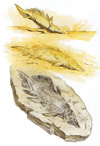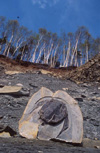Records of past life
Paleontology, the scientific study of fossils, is the union of two scientific disciplines.
 (40 kb) Discoveries in geology help us understand how different rock types formed and how they trapped the remains of dead organisms. Biology helps us deduce how these ancient beings lived, how they interacted with their ecosystems, and their position in the great evolutionary tree.
(40 kb) Discoveries in geology help us understand how different rock types formed and how they trapped the remains of dead organisms. Biology helps us deduce how these ancient beings lived, how they interacted with their ecosystems, and their position in the great evolutionary tree.
We find fossils in sedimentary rocks, meaning rocks derived from the accumulation of sediments (mud, clay, sand, gravel, etc.). The Escuminac sedimentary formation at Miguasha was the result of the weathering and erosion of the young Appalachian mountain chain, which loaded streams and rivers with silt and rock debris.
 (76 kb)Slowing their course as they approached sea level, the rivers deposited this sediment load into a large estuary. Within that watery realm, dying fish, plants and invertebrates settled to the estuary floor where they were rapidly covered with sediments. Others were buried alive by sudden slides of mud and sand. Whatever the means, burial initiated the process of fossilization.
(76 kb)Slowing their course as they approached sea level, the rivers deposited this sediment load into a large estuary. Within that watery realm, dying fish, plants and invertebrates settled to the estuary floor where they were rapidly covered with sediments. Others were buried alive by sudden slides of mud and sand. Whatever the means, burial initiated the process of fossilization.
Sediments are turned to rock when compacted under their own weight and subjected to various chemical processes. After millions of years, tectonic movements can slowly raise the rocks of ocean floors, sometimes forming new mountains that will in turn be subjected to erosion. This cycle of “erosion–sedimentation–compaction” has been happening on Earth for as long as there have been solid rocks and liquid water to erode them; that is, for more than four billion years.
A fossil is the exception, rather than the rule. Normally, all that lives and dies decomposes and is reused by the next generation of living beings. Under certain conditions, however, the hardest parts of an organism (bones, teeth, spines, scales, shells, carapaces...) cannot decompose and rest entombed in sediments. Ideal conditions for fossil preservation are typically found at the bottom of oxygen-poor waters where some of the bacteria involved in decomposition cannot survive, thus leaving the hard remains intact. Other bacteria contribute to the fossilization process by turning soft tissue into minerals. As the sediments surrounding them become rock, chemical processes transform the creature’s remains so that they also resemble rocks.
Subjected once again to erosion, this time by the Ristigouche River, the rocks in Miguasha’s cliff reveal fossilized creatures that have lain dormant for 380 million years. Around the world, fossils like those at Miguasha represent valuable records of past life, teaching us about the prevailing conditions so very long ago and providing some of the most important evidence for the theory of evolution.

 (40 kb) Discoveries in geology help us understand how different rock types formed and how they trapped the remains of dead organisms. Biology helps us deduce how these ancient beings lived, how they interacted with their ecosystems, and their position in the great evolutionary tree.
(40 kb) Discoveries in geology help us understand how different rock types formed and how they trapped the remains of dead organisms. Biology helps us deduce how these ancient beings lived, how they interacted with their ecosystems, and their position in the great evolutionary tree.We find fossils in sedimentary rocks, meaning rocks derived from the accumulation of sediments (mud, clay, sand, gravel, etc.). The Escuminac sedimentary formation at Miguasha was the result of the weathering and erosion of the young Appalachian mountain chain, which loaded streams and rivers with silt and rock debris.

 (76 kb)Slowing their course as they approached sea level, the rivers deposited this sediment load into a large estuary. Within that watery realm, dying fish, plants and invertebrates settled to the estuary floor where they were rapidly covered with sediments. Others were buried alive by sudden slides of mud and sand. Whatever the means, burial initiated the process of fossilization.
(76 kb)Slowing their course as they approached sea level, the rivers deposited this sediment load into a large estuary. Within that watery realm, dying fish, plants and invertebrates settled to the estuary floor where they were rapidly covered with sediments. Others were buried alive by sudden slides of mud and sand. Whatever the means, burial initiated the process of fossilization.Sediments are turned to rock when compacted under their own weight and subjected to various chemical processes. After millions of years, tectonic movements can slowly raise the rocks of ocean floors, sometimes forming new mountains that will in turn be subjected to erosion. This cycle of “erosion–sedimentation–compaction” has been happening on Earth for as long as there have been solid rocks and liquid water to erode them; that is, for more than four billion years.
A fossil is the exception, rather than the rule. Normally, all that lives and dies decomposes and is reused by the next generation of living beings. Under certain conditions, however, the hardest parts of an organism (bones, teeth, spines, scales, shells, carapaces...) cannot decompose and rest entombed in sediments. Ideal conditions for fossil preservation are typically found at the bottom of oxygen-poor waters where some of the bacteria involved in decomposition cannot survive, thus leaving the hard remains intact. Other bacteria contribute to the fossilization process by turning soft tissue into minerals. As the sediments surrounding them become rock, chemical processes transform the creature’s remains so that they also resemble rocks.
Subjected once again to erosion, this time by the Ristigouche River, the rocks in Miguasha’s cliff reveal fossilized creatures that have lain dormant for 380 million years. Around the world, fossils like those at Miguasha represent valuable records of past life, teaching us about the prevailing conditions so very long ago and providing some of the most important evidence for the theory of evolution.
Site map | Feedback | Links | Sources | Credits
Records of past life
<< In search of our origins | The notion of geologic time >>

Title: The process of fossilization
Author: Illustration by François Miville-Deschênes
Sources: Parc national de Miguasha
Year: 2001
Description:
The process of fossilization, illustrated here with the death of the dipnoan fish Fleurantia denticulata, begins with its burial in sediment and ends with the preservation of its hard parts in sedimentary rock.



